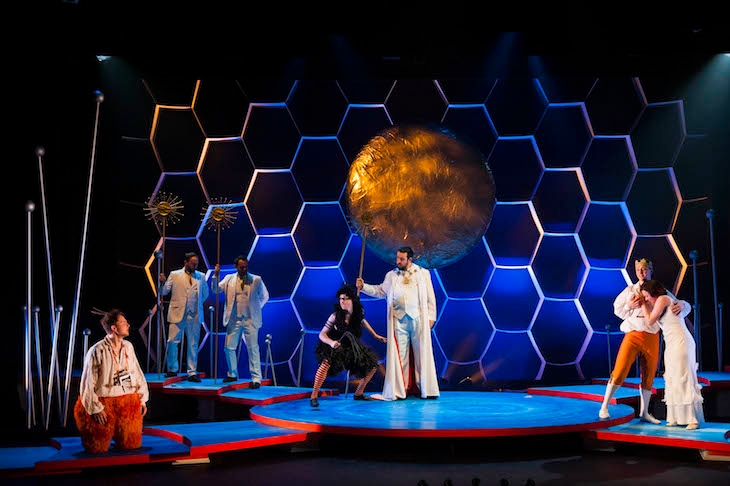The Magic Flute
Mid Wales Opera, touring until 4 May
The backdrop is a hexagonal matrix, glowing in neon blue. Mist billows from the wings, and as a figure in a pink gas mask huddles in the foreground, a Victorian funeral party marches slowly across the stage. ‘Where am I?’ asks Tamino in the first scene of The Magic Flute and in Richard Studer’s new production for Mid Wales Opera, the answer seems to be the faintly eerie world of 1970s British sci-fi – an episode of Sapphire and Steel perhaps, or Tom Baker-era Doctor Who. Well, why not? Mozart and Schikaneder – whose libretto invokes Egyptian gods while specifying that Tamino should wear ‘Japanese hunting costume’ – clearly weren’t too fussed. I’ve seen The Magic Flute staged as a world war one drama, a manga cartoon and a homage to Magritte. It works every time.
No, what’s most surprising here is that this production exists at all. In 2015 Mid Wales Opera – which had been touring small venues in both Wales and England since 1988 – ran into funding difficulties and went ominously quiet. That, it seemed, was that. MWO’s recent appointment of Studer and the conductor Jonathan Lyness as a new artistic leadership was the company’s first real vital sign in some time. These two have form, including a particularly raw and passionate Jenufa at Longborough last summer. And by the look of their new Flute, which opened on Friday night in Newtown, Mid Wales Opera isn’t merely off life-support: it’s back in the game and punching straight into the same league as English Touring Opera, a company whose only artistic compromises relate to the size of its venues.
The casting’s the key. These are youngish singers, but they all have credible CVs, and three performances would stand out in any production: Sion Goronwy’s imposing and sonorous Sarastro, Galina Averina’s vulnerable, eloquently-sung Pamina and – as the Queen of the Night – Samantha Hay, who’s sung this role for ETO and Welsh National Opera, and whose interpretation only seems to grow in haughty brilliance. William Wallace (Tamino) and Frederick Long (Papageno) had an enjoyably blokish comic rapport. Crucially, since there are no surtitles, they all enunciate the English text clearly and naturally. There’s no chorus either, but Lyness conducts his ten-piece orchestra with zest and intense expression – and for good measure, plays Papageno’s glockenspiel too, as Mozart himself did in 1791.
As for that production: thanks to some deft lighting, it doesn’t look bad, and Studer’s designs clearly delineate who’s on whose side (Monostatos in black feathers as a kind of anti-Papageno was a neat touch). The theatre was full, the laughter frequent and at the transcendent moment when Pamina steps forward to share Tamino’s ordeals and Mozart’s score brims over with dignity and compassion, I felt that essential, unmistakable pricking behind the eyes. If you’re within striking distance of Bangor, Aberystwyth, Pontardawe or Newport, go and see it. You won’t just receive a thoroughly entertaining shot of Mozartian optimism – you’ll be doing something positive for the future of British opera.






Comments